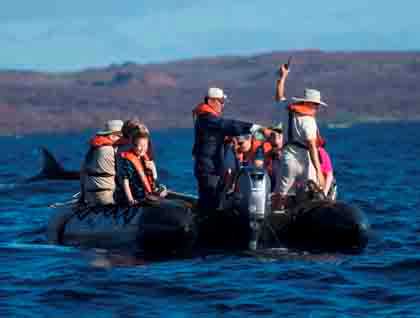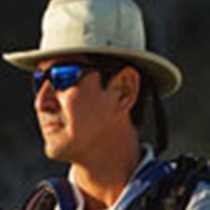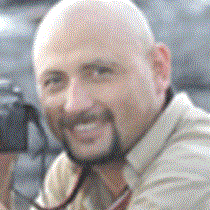Early in the morning we woke up in the central part of the archipelago. We are now located at a very small and very famous island. Bartolomé has the world-famous Pinnacle Rock, which has been seen by many for it has been published in many books and filmed in many documentaries worldwide. We call it “our open book of geology,” a misfit island for it has no Palo Santo forest and yet, after at 2.5 million years, we believed Bartolomé should be full of endemic biota. It’s wonderful to see Mother Nature keeping secrets and as a result we could admire geological features first hand.
We were beginning our journey to reach 315 feet in altitude with a walk of about 372 wooden steps, when suddenly one of our guests spotted a spout in the distance. Immediately we called the Zodiacs so we could view it from hopefully a shorter distance. They were orca whales so this was a true journey of discovery, a real expedition, full of excitement and wonder. When we arrived we were lucky to see a large female and two younger calfs. Frigatebirds and many more seabirds were on the premises indicating the killer whales were feeding. Unexpectedly we spotted a green pacific turtle at the surface, soon after the whale came and took it under, deeper into the abyss, and we presumed it was eaten as many more seabirds approached the site for remains. This majestic moment in life will stay in our hearts forever, to see the curiosity of a young orca approaching us, as we presumed a mother was teaching her two youngsters to hunt. We felt closer to our marine cousins, our families, as we are both mammals, marine and terrestrial, and yet we shared isolation in the intimacy of the Galapagos.
Back onboard we had our breakfast and went out for water activities. Some of us went snorkeling, others boarded our glass-bottom boat, and some just took a towel and laid on the sand for more relaxation.
Later, as we repositioned our ship we passed next to a chain of volcanoes. Inside one we could see from afar some flamingos in the inner caldera. Meanwhile our naturalist Fernando made his presentation about Charles Darwin and the Galapagos Islands.
Next was snorkeling at Sombrero Chino. Here we have an impressive underwater landscape where black lava meets the white sand. Great visibility and many more species such as sharks, rays, penguins, and of course many varieties of fish. Soon after we had a Zodiac ride along the shoreline of James Island searching for Galapagos penguins, and we were also lucky to watch two Galapagos hawks gliding over us. Then it was back onboard for a succulent barbeque dinner.
Later at night, it was time to reminisce about the many experiences of such a wonderful day, now under moonlight. As we look back and gaze at these islands for the last time, understanding tomorrow will be our last full day, this place now seems to be timeless. It is now deep within our hearts and our experience has been unforgettable, a place where wildlife that has no fear and allows us to realize that we are not so different after all.
And so my deep thought for our younger generations: “We must not acknowledge the methodical saying ‘don’t humanize the animals’ (as we were taught in school) but instead ‘animalize the human’ by perceiving our surrounding with all our senses; embracing nature by coexistence and respect for one another, so we can become one with nature as we once were.” Celso Montalvo.
Adiós amigos.






